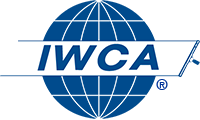IWCA Professional Window Cleaning Industry Standards, Best Practices, & Member Education Resources
The IWCA is committed to research and development of safe practices and promoting sustainable long-term care, maintenance, and restoration of architectural glass products and solar panels. From residential to commercial high-rises, the markets we serve consist of billions of dollars of architectural glass products.
The IWCA brings nearly four decades of expertise, funding, and research to our membership and the window cleaning industry in general, boosted by support from Associate Members and the National Glass Association (formerly GANA, now NGA). The IWCA provides the latest in industry cleaning specifications, bulletins, and white papers to educate our members to become specialists in the chemistry of window cleaning.
Introduction to Routine Window Cleaning
IWCA Glass Surface Maintenance Matrix—The majority of ongoing maintenance of architectural glass and metal surfaces is considered “Routine Cleaning.” The IWCA Glass Surface Maintenance Matrix defines these methods, tools, and cleaning solutions.
IWCA Guide to Architectural Glass for Professional Window Cleaners—This member resource guide is an essential training tool for all professionals engaged in routine window cleaning. The IWCA Guide to Architectural Glass for Professional Window Cleaners provides an in-depth understanding of how glass is manufactured, the coatings that can be damaged if not cleaned properly, and technical guidance for company owners and technicians.
IWCA/NGA Publications—These publications apply to routine window cleaning and include “Proper Procedures for Cleaning Architectural Glass Products” and “Proper Procedures for Cleaning Flat Glass Mirrors.”
Non-Routine Window Cleaning
Non-routine window cleaning includes architectural glass surface restoration, final construction cleaning, and stain and scratch removal. The IWCA resource materials include cleaning methods and specifications to assist in educating your workforce. Learn how to provide the best quality workmanship and avoid costly litigation caused by improper cleaning methods or product selection.
Recent advances in the technology of mechanical polishing of glass in the field allow scratched or graffiti-etched glass to be repaired economically, without the use of acids.
IWCA Glass Surface Maintenance Matrix—The Non-Routine Window Cleaning section of this Matrix defines methods, tools, and cleaning solutions for removing tenacious surface deposits, stains, and scratches. Professional window cleaners encounter a myriad of hardwater stains, paint, concrete, and other deposits that, if improperly removed, can damage the glass, the coatings, and adjacent surfaces such as metal frames.
IWCA Guide to Architectural Glass for Professional Window Cleaners—This member resource guide is an essential training tool for all window cleaners and provides an in-depth understanding of identifying and removing stains, starting with non-destructive stain removal using microcrystalline abrasives and solvents, and moving to more aggressive compounds from weak to strong acids and the precautions to take.
Glass Restoration Standards Reference Handbook 2025 IWCA Edition– This guide is a valuable addition to our Technical publications, bulletins, best practices, and innovative solutions for addressing surface damage on glass. The handbook is a comprehensive guideline for architectural glass restoration and a user manual for mechanical field polishing. It includes solutions for removing hard water stains, scratches, and damage from vandalism or improper cleaning.
Other Resources
Listed below are additional resources for professional window cleaners and managers, specifiers, architects, general contractors, restoration or glazing contractors, and residential builders.
“Construction Site Protection and Maintenance of Architectural Glass”—This IWCA/GANA (now NGA, the National Glass Association) bulletin details the methods of protecting glass and glazing products, including metal or wood frames during construction and restoration. Improper storage can often cause irreparable damage or require costly restoration due to scratches, concrete, waterproofing, or other incompatible materials or activities. This is an essential bulleting for glaziers, general contractors, window cleaners, and others related to glass protection during construction activities.
“Tempered Glass Products Are Different”—Scratched glass is problematic for all. When it is caused by improper use of razor blades or by removing hardened concrete from glass, tempered glass is much more likely to be scratched than annealed glass. Protect your company by educating your workforce on the care required for tempered glass.
ASTM Standards—The American Society for Testing and Materials (ASTM) is a nonprofit organization that develops and publishes approximately 12,000 technical standards. All of these are copywrite protected and must be purchased from the ASTM website. The most common ASTM Standards that apply to architectural glass quality include the following, which cover laboratory testing and field evaluation.
- ASTM C1036—Standard Specification for Flat Glass. This standard covers the quality requirements of flat, transparent, clear, and tinted glass. This specification is focused on the quality of the flat glass as produced, covers laboratory testing, and covers filed evaluation guidelines for annealed glass.
- ASTM C1048—Standard Specification for Heat-Strengthened and Fully Tempered Flat Glass. This specification is the same as ASTM C1036, covering tempered glass products.
- ASTM C1172—Standard Specification for Laminated Architectural Flat Glass
A Message From the IWCA Glass Education Committee
Your membership helps to support ongoing technical research and education. We are here to help you solve the problems that are typical of glass maintenance and restoration. We encourage members to contact us with any technical questions, submit case studies, or apply to serve on the committee. Please send these requests to info@iwca.org.

